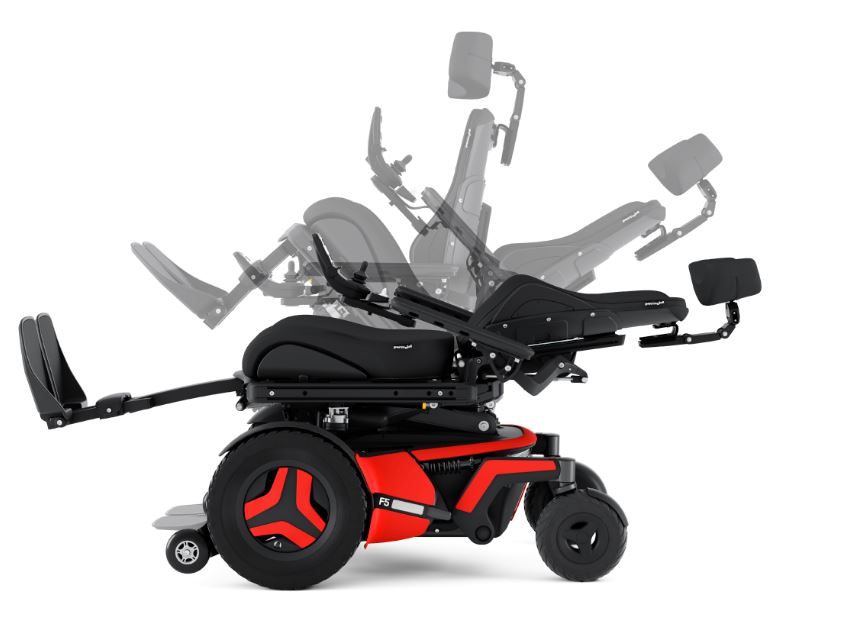We have been discussing the importance of power seat functions for the past couple blogs and what those power seat functions can do for the user. Often because of the limited mobility of the individual utilising the power wheelchair, power seat functions are used for pressure management. Pressure management or shifting weight off the user’s bottom is crucial to help to decrease the risk of skin breakdown. There are numerous research studies that discuss which combination of power seat functions are best for pressure management. The research shows that superior pressure relief may be achieved by utilising both posterior tilt and recline. Based on research by David Kreutz in 1997, the individual is recommended to initially move to a fully tilted position to stabilise the pelvis, and then follow with activation of the recline system so as to minimise loss of postural stability. Then reverse this order for coming back up to a driving or functional position: Recline and then tilt. This order is important because if the user starts for example with power recline they may lose their stable seated position or increase shearing to their sacrum. Commonly, users will have access to power posterior tilt, power recline, and power elevating legrests. In this case, the user should complete the following sequence for pressure management: posterior tilt, elevating legrests, recline. Then, reversing this order for coming back out to an upright driving position. When the user is fully tilted and reclined, this position is also helpful to reposition the user. Many users may be able to unweight their pelvis and shift their own hips in this unweighted position.
So, what is the challenge with utilising the sequence of posterior tilt, elevating legrests, and recline to maintain postural stability during pressure management? This sequence can be difficult for the user to remember, or maybe the user does not know the difference between recline and posterior tilt if they were not educated by their therapist or other seating specialist. This can create a fear for therapists and many will prescribe just posterior tilt in order to prevent the potentially negative effects of the 3 power seat functions when not used in the right sequence. Or, maybe the user is given all 3 power seat functions, but instructed to only use tilt for their pressure management. This is where it is important for manufacturers to see this limitation and develop a solution.
This solution for Permobil is called Independent Repositioning Mode or IRM. IRM comes standard on every F series, M3 and M5 power wheelchair. This mode can be turned on to where the user can press a button on the controller, hit a switch, or use the actual joystick to enter the independent repositioning mode. Because the chair has smart actuators, when the switch for example is hit, the chair will take the client into a pre-set or therapist set amount of tilt, legrest elevation, and recline in the proper sequence one after the other. The user only has to know in this case to hit one button. Users no longer have to worry about going all the way into posterior tilt before elevating their legs and then reclining. This feature is designed to take the stress and difficulty away from the user, but also empower the user to be able to be independent with their own pressure management. Independent repositioning mode can also help with exactly what it says – repositioning. For some users, they are able to hit a button and go into this position so that they can independently repositioning their seated posture. While the user can be set up for the standard IRM position, the therapist can also choose the final position of IRM so that this feature can be utilised for every users’ needs.
References:
Kreutz, D. 1997. Power tilt, recline or both. Team Rehab Report, March: 29–32.

Rachel Fabiniak PT, DPT
Director of Clinical Services
Rachel Fabiniak began her studies at The Georgia Institute of Technology, where she graduated with her Bachelor of Science in Biology in 2009. Rachel then went on to receive her Doctorate in Physical Therapy from Emory University in 2013. After receiving her doctorate, Rachel went into clinical practice as a physiotherapist in the Spinal Cord Injury Day Program at Shepherd Center in Atlanta, Ga. Rachel also has experience in community physiotherapy and inpatient rehabilitation. During Rachel’s time at Shepherd Center, she developed a passion for seating and mobility which ultimately led to her career with Permobil. Rachel joined on with Permobil in January 2018 and relocated to Sydney, Australia in June 2018 as the clinical education specialist for Australia and New Zealand. In February 2020 Rachel moved into the role of Director of Clinical Services for Asia-Pacific.
